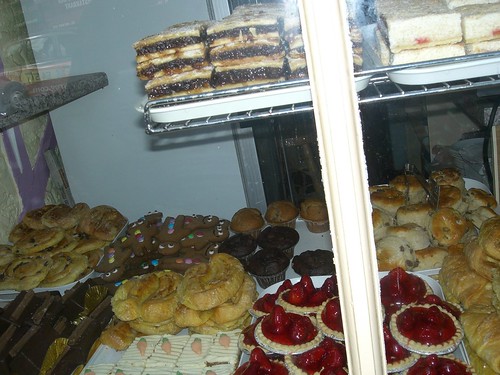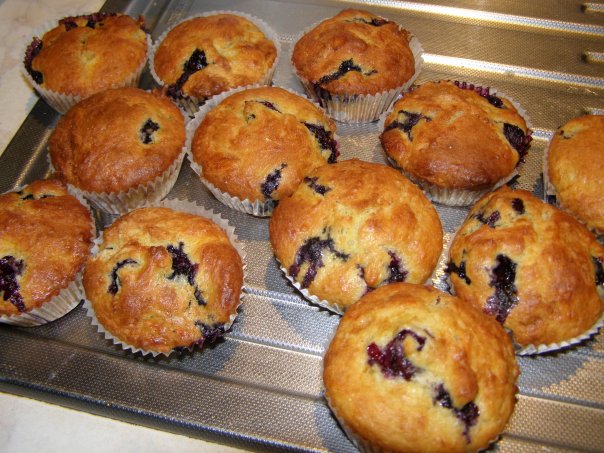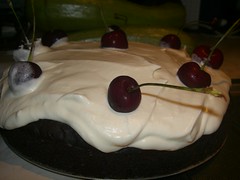I almost forgot my son's birthday tomorrow (what kind of a mother am I?) whichmeans he's going to need to take some sweets with him to school. As we are a small family with few close relatives and next-of-kin living close by to us, we usually hold small celebrations. But there is a nice Greek custom of sharing out cakes and sweets on your nameday or birthday (or both) at your workplace, and this extends to schoolchildren, among their classmates. This custom suits us to a tee: Aristotle will be surrounded by his friends, there'll be no mess to clean up afterwards, and he'll hear a chorus of well-wishers singing the Greek 'Happy Birthday' song to him:
"Αριστοτέλη, να ζήσεις και χρόνια πολλά, (To Aristotle, a good life and many years,)
μεγάλος να γίνεις με άσπρα μαλλιά, (may you grow old with white hair,)
παντού να σκορπίσεις τις νιότης το φώς, (wherever you go, spread the light of youth)
και όλοι να λένε "Να ένας σοφός"! (and everyone will say 'Now there's a wise man'!)
The custom is to buy some ready-made individually wrapped cream cakes or chocolates, or to send off a big cream cake with candles on it. These cakes are always bought from a local confectioner's or patisserie. The packaging is always luxurious, and of course, unnecessary. It is true that you need the time and inclination to make something home-made. I decided to make some luxurious-looking, scrumptious muffins, which took only 10 minutes to make, and another 20-25 minutes to cook. They look spectacular, and they remind me of my husband's introduction to this very non-Greek dessert.

It was cold, damp and drizzly Friday in London as we were walking around near the Bank of England. At one point, it started pissing with rain, so we decided that we would have to take shelter somehow. We ended up eating a rather early lunch close to St Pauls' in the City at a cafe which served lots of ploughman's lunches for burly construction site workers, as well as more refined meals like chili con carne and curried chicken. We each had one of those, while the children ate a tomato-sacue peene pasta dish. Quite a few businessmen were also haveing lunch or coffee there, while they were constantly on their cellphones. The food was very hearty, and I liked its light taste. It filled you up and it wasn't too oily. The dining room area was the most intriguing part of the visit. It reminded me of Charles Dickens' Christmas story; with its red brick-built walls, it looked like an underground sewer that had been drained and turned into a dining room. The roof was covered in brick arches, and in one corner, there was a disused fireplace. All that was missing was a poor Victorian family huddling around it. I could imagine a family of wretches living there in the 1850s; either that, or it could have been the kitchen area where the cook would prepare meals downstairs, then put it in the hatch (there was one above the fireplace) and ring the bell for the servants to pick up upstairs and serve it to the lady and the lord who lived there. There were no windows, so whoever lived or worked there could never see the sun, or get any fresh air. Spooky if you have never seen this sort of place before. The waitress, interestingly enough, was Portuguese.
Being a bold traveller, I asked her about how she ended up in London, and what her future plans were. She opened her heart out to us; I suppose she didn't often see families coming in to this diner and she could relate to us as fellow Mediterraneans. She had left Portugal with her husband because of the high unemployment they both faced there. They were both working in various jobs, trying to save as much money as they could in order to go back home for good one day. She had gotten very depressed lately, because of the high cost of living in an overcrowded city with a bad housing situation - she and her husband lived in a tiny one-bedroom apartment, which cost them most of her own pay from working at the diner. She couldn't even think of having children becuase of the expenses and the lost income. She also complained about the food; Portuguese specialties were not easy to obtain of course, and when they were available, they were quite costly. She told me she didn't know how long she would be able to endure London life, and being away from her family. I felt sorry for her.
The waitress reminded me of my parents who left their villages in Crete because they were poor and knew that they had no prospects of self-improvement in their own homeland. I wondered what my life would be like now if they hadn't done that. I wondered if I might have been this young lady, leaving my poor origins behind in search of better prospects. My own success in this globalised world is due in part to their sacrifices. I ended up leaving my own homeland and making my new home in another part of the world, but for completely different reasons from my own parents - I felt like a change, it wasn't a situation forced on me for economic reasons.
'Anyone for sweets?' I knew that only the children would say yes, only to be cut down by a no from their father, but the muffins did look tempting in the shop. 'It's a traditional kind of English sweet'. (All a lie, of course; the
original muffin was the English 'crumpet'. It was America that gave us these moist little cakey beauties.) I shouldn't use the word 'English' when I mention food to him. He's never tempted by anything British. It's all Greek to him, or should I say,
for him. 'Shall we buy some for later?' 'Oh, we'll find another place to eat by then.' With a full stomach, he didn't feel like anything just then. He was right - we would find something else later, but waht annoyed me was his disinterested attitude toards foreign food. Travelling for me is a taste sensation; even if I have never heard of something before, I would be willing to eat it if only to try it out. I would feel a failure if I didn't try a local delicacy while I was travelling in a foreign place. Food is undoubetdly part of the sholw cultural experience when you are a tourist. I'm not talking about package tourists who come to Greece for the three three-letter S-words (sea, sun, and I think the last one is sex). They are not coming to Greece for the cultural experience; they are coming to get what they can't enjoy in their own country.

I was rather annoyed with my husband at that point. I had tired of his thinking that I am an unsatiable piglet who'll eat anything put before her, in any quantity, becasue she keeps no law and order in her daily diet. Aren't I the one who introduced him to c
hili con carne,
chicken curry and
guacomole? Wasn't I the one who preserved the fruits of his gardening labours and turned them into traditional Greek concoctions such as
boureki,
moussaka and
yemista? I now know I should not have heeded his advice. He made exactly the same comment when we passed a window full of traditional English sweets while we were in Greenwich (where we vistied the the National Maritime Museum and the Royal Observatory - very informative places set in the most beautiful - for me - suburb of London); whereas I was able to name every single item in the shop window, he was stared at it with that "It's all Greek to me" look (pardon the pun), and wondered if his wife had simply turned gluttonous. It had been a long
long time since I had seen jam pie, custard squares, currant buns, chocolate muffins, blueberry muffins, gingerbread men, Danish pastries, fudge bars, carrot cake, strawberry tarts and fresh croissants
all in one place. As I looked at each one from the street, I could taste it in my mind, just like Peter Pan and Captain Hook's lost boys, who never saw the food they ate, and had to use their imagination to believe that they were actually eating food.
When we left the cafe, it was still raining. London is a fantastic city for all kinds of weather: if it's sunny, the parks are a delight for all ages. When it's wet, you can take shelter in the nearest museum. We took the tube to Russell Square and visited the British Museum, a building that looks like the Greek Parthenon, and houses - well, the Greek Parthenon. After admiring the various works on display, all of which were not British (which begs the question that the museum should be renamed), and which unfortunately were not as many as the museum holds due to continued staff shortages, I decided it was time for a coffee break. We had been walking around for three hours (with children) by then. I bought a couple of hot chocolates for the children some coffee for me and my husband. Then I saw them - enormous, velvety, chocolate muffins. In fact, they sold the whole gamma of muffins - classic blueberry, plain and chocolate muffins. I bought one of each. As usual, I contented myself with pecking a bit off everyone else's food. It was my husband's first chocolate muffin ever. He fell in love with them, and who wouldn't? These muffins were huge, sticky and firm on the outside, and moist on the inside. The chocolate that was used in them virtually melted in your mouth.



When we left the British museum (which wasn't quite as British as it makes out to be), on our way to the hotel, we passed the grocery shop which sold milk, bread, fresh fruit, some packaged vegetables and a range of newspapers and magazines, along with a wide variety of sweets to satisfy the British sweet tooth. I always bought myself a tub of (imported Dutch) raspberries from there, which my other half would scoff at (he couldn't understand why I would want to eat berry fruit in the cold weather); as he waited for me to buy the raspberries, he spotted some packaged muffins. Sweets and desserts are also his downfall, so he bought a couple of each type that they sold in the shop. When we got to the hotel, and had had our showers and settled down in our pyjamas, he tried the chocolate muffin. It was a little stale; the chocolate used to make it can't have been good quality and it was not moist and chewy. In fact, it resembled a bread-like cake. What a diappointment. Well, what did he expect from a corner store?

Here is the best and simplest recipe (from
www.cacaoweb.net) I have ever tried for muffins. They come out puffy, firm and moist on the inside. I omitted the chocolate chips (I had none in the house). This recipe makes 12 medium-sized muffins. I have made these muffins before, and I prefer to keep them on the small side so that my children learn to limit themselves to the right kind of serving. One large muffin is equivalent to 2 small muffins, but when you tell a child to eat one, it won't differentiate between size differences!
For the sake of convenience,
the recipe is repeated here:
2 eggs
1 cup (200 g) sugar
1 cup (130 g) all-purpose flour
6 tablespoons
unsweetened cocoa powder2 teaspoons baking powder
1 teaspoon vanilla essence
2/3 cup (160 ml) milk
2/3 cup (160 g) butter
4 oz (120 g)
semisweet chocolate chips (optional)
Preheat oven to 350 deg F (Gas mark 4 or 180 deg C). Grease 6 large (or 12 small) muffin tins or cups (paper muffin bake cups are recommended). Beat the eggs with sugar, mix with flour, cocoa powder, baking powder, vanilla and milk. Fold in the melted butter. Add chocolate chips (the recipe states that these might end up in the bottom of the muffin -
that's why I won't bother using them inthe future). Pour the mixture into the prepared muffin cups; the higher you fill them, the puffier they will come out, the more cooking time they need. Bake at 350 degrees until a until a wooden pick inserted in center comes out clean, approximately 20-30 minutes, depending on the size.
These muffins must have been delicious - I am afraid I didn't get a chance to try one out, because the pieces were measured out one per child - because when I went to the school to pick him up, some children in Aristotle's class told me they really liked them. Aristotle also told me that I had never made a better cake. Oh dear, maybe I'm just being too cruel to be kind when I overdo it with the
banana cake and
carrot cake muffins. They're all freezable, defrosting nicely in a child's lunchbox, in time for the morning break at school.
©All Rights Reserved/Organically cooked. No part of this blog may be reproduced and/or copied by any means without prior consent from Maria Verivaki.
MORE CHOCOLATE:
Afghans
Brownies
Simple cake
Choclate balls
Chocolate pancakesChocolate cake





























